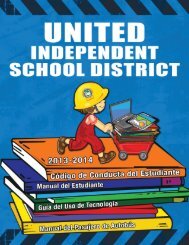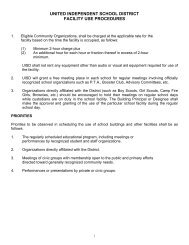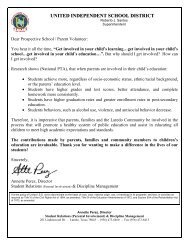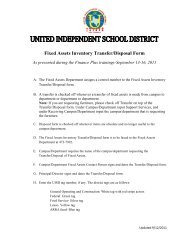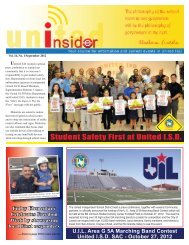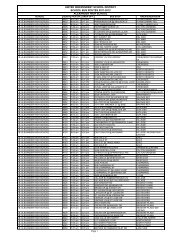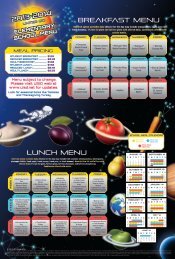Rtl Guide 2013-2014 - United Independent School District
Rtl Guide 2013-2014 - United Independent School District
Rtl Guide 2013-2014 - United Independent School District
You also want an ePaper? Increase the reach of your titles
YUMPU automatically turns print PDFs into web optimized ePapers that Google loves.
TABLE OF CONTENTS23CONTRIBUTORS4PYRAMID OF INTERVENTIONS5INTRODUCTIONUISD RtI Philosophy Statement5RtI Mission Statement5Vision of UISD Graduate5What is RtI?6Roles and Responsibilities of RtI Team 7PROGRESS MONITORING. 10TIERS12Tier I Flow Chart13Tier I <strong>Guide</strong>14Tier II Flow Chart38Tier II <strong>Guide</strong>39Tier III Flow Chart56Tier III <strong>Guide</strong>57APPENDICES71Glossary and Strategies74RtI DefinitionsResources80<strong>District</strong> Research-Based Programs81Webliography - Web Resources for RtI87References88TABLE OCONTENTS2
Pyramid ofInterventionsAcademicIntensive, IndividualInterventionsTier III1-5%(1-2/22)(1-2/30)BehavioralSystemIntensive, IndividualInterventions• Individual Students• Assessment-based• High IntensityTargeted GroupInterventions• Some students (atrisk)• High efficiencyTier II5-10%(1-2/22)(2-3/30)• Individual Students• Assessment-basedTargeted GroupInterventions• Some students (atrisk)• High efficiency• Rapid response• Rapid responseUniversal InterventionsUniversal Interventions• All students• Preventive,proactiveTier I80-90%(18-20/22)(24-27/30• All settings, allstudents• Preventive,proactive4
RtI Philosophy Statement<strong>United</strong> ISD believes that ALL children can learn. RtIprovides students with interventions that will allow thestudent to be successful in the classroom. Therefore, <strong>United</strong>ISD implements the Response to Intervention process at allgrade levels and at all campuses to assure that ALL studentsmeet their academic potential.UISD RtI Mission Statement<strong>United</strong> ISD will provide each student with high-qualityscientifically research-based general education instruction.When appropriate, a student will also be provided withstrategic and intensive intervention supports matched to his/her needs.<strong>United</strong> ISD utilizes the RtI process which combines:1. Scientific research-based interventions in the generaleducational setting,2. Decision-making and multi-tiered service delivery modelto improve educational and behavioral outcomes for allstudents,3. Systematic assessment for the measurement of thestudents response to implemented interventions, and4. An on-going problem-solving approach in progressmonitoring documentation and feedback to the RtI Team.(OSPI, 2007)Vision for a UISD Graduate<strong>United</strong> ISD strives to prepare all students for a productiveself-sufficient post-secondary career and college readylifestyle and inspire students to become responsible worldcitizens by pursuing excellence through life-long learning.INTRODUCTION5
What is Response to Intervention (RtI)?According to the National Research on Learning Disabilities, RtI is anassessment and intervention process within general education settings forsystematically monitoring student progress and making decisions about the needfor instructional modifications or increasingly intensified services usingprogress data (NRCLD, 2008).Both IDEA 2004 and NCLB call for improving outcomes for all students byusing scientifically based instructional practices. RtI specifically requiresthorough documentation of appropriate use of scientifically based interventionswithin general education settings. The most critical component in RtI is the Rwhich is Response. Monitoring of a students response to high qualityscientifically based classroom instruction is the vehicle for attaining school wideacademic excellence.According to the Texas Education Agency, implementation of activitiesassociated with Response to Intervention (RtI) is expected to have a positiveeffect on schools across the state. RtI may be described as a model addressingthe needs of all students through a continuum of services which provide: (1)high-quality instruction and scientific, researched-based, tiered interventionstrategies aligned with individual student needs; (2) frequent monitoring ofstudent progress to make results-based academic or behavioral decisions; (3)data-based school improvement; and (4) the application of student response datato important educational decisions (such as those regarding placement,intervention, curriculum, and instructional goals and methodologies).General and Special Education Collaboration: The activities described abovetypically occur in the general education setting as schools assist strugglingstudents prior to and, often, in lieu of a referral to special education. Localeducation agency (LEA) general and special education staff will need tocoordinate and collaborate in developing a process implementing thisframework. Divisions within the Agency work closely to develop policyguidance regarding RtI that includes both general and special educationconsiderations.6
Roles and Responsibilities of the Campus RtI TeamThe primary responsibility of the Campus RtI Team is to ensure that students are provided themaximum opportunity to be successful in the regular education program. The Campus RtITeam provides instructional support to the classroom teachers in order to assist them in theirefforts to efficiently improve achievement of students who are experiencing learningdifficulties. The Campus RtI Team will review progress monitoring and benchmarks of atriskstudents. The Campus RtI Team monitors direct instruction interventions to ensureinstructional integrity and fidelity.The purpose of the Campus RtI Team is to support the efforts of classroom teachers to deliverappropriate and effective instructional interventions and strategies which will beadvantageous to all students.The process of the Campus RtI Team should be ongoing to assist in resolving issues,problems or concerns linked to students achievement. At the campus level, the Campus RtITeam is composed of:• the chairperson (principal)• a counselor• a general education teacher/team leader/Pathfinders• a special education teacher• the reading intervention teacher• the regular education teacher of the student being reviewed• other professionals (i.e. instructional coordinators, bilingual specialist, behavior specialist,social worker, dyslexia teacher, speech/language pathologist, diagnostician, etc.) may beactive members of the RtI Team when additional support is neededThe Campus Principal will:• chair the RtI Team meetings• provide the vision and action plan for implementing RtI• provide appropriate time and structure to implement the RtI process• integrate RtI and school improvement efforts• lead staff in discussion about data obtained through RtI• assist Counselor in facilitating building RtI meetings• involve key staff members in RtI• provide leadership to RtI Team in the determination of effective instructional interventionsfor each student• monitor the implementation of direct instructional interventions and strategies conductedthrough small groups targeting specific skills with integrity and fidelity• outline the teams agenda7
• supervise record keeping• oversee follow-up procedures• provide necessary technology, materials, resources, and professional development to staff• provide initial and continuing professional development opportunities for new staff andongoing training• determine when/whether classroom performance warrants intervention (e.g., entire classperformance is considerably lower than other classes in the same grade level)• provide aggregated data from school-wide screening results to teachers and districtpersonnelGrade Level/Academic Team Leader/Department Head*• facilitate grade level/academic team/department head team meetings• share knowledge of RtI with team• help team to focus on problem solving steps and data collection• help teachers with folder reviews• collaborate with other grade level/academic team leaders/department heads• serve on the campus RtI team and provide input on each student• Serve as a liaison between grade/academic team leaders/department heads and the campusRtI team• prioritize students and group them according to needs, when appropriate• help teammates problem solve and monitor interventions• prioritize students from campus RtI review• Focus on intentional RtI during instructional planning• provide leadership to team in the determination of effective classroom interventions foreach student• lead the dialogue and review of interventionsCounselor• provide ongoing support to grade team/academic team/department heads• help to identify training needs and facilitate training with campus/district resources• coordinate the collection of data with team leader, academic team and department heads• provide information to teams about RtI and various topics• provide input at each RtI meeting• monitor and document the effectiveness of the RtI behavioral strategies• schedule campus RtI meetings in collaboration with campus principal• inputting of special education RtI referral into esped*Pathfinder teachers may serve in this role.8
RtI Team Members will:• review the students universal screening results (TPRI, STAAR, TELPAS, etc.)• review progress monitoring results and/or benchmarks• review the students current performance• determine the students learning needs• design appropriate instructional interventions• assign responsibilities for implementation• develop a follow-up planThe General Education Teacher of the student being reviewed will:• contact parents about concerns and progress• ask for and/or offer help with problem solving• carry out interventions with fidelity and efficacy• monitor and evaluate interventions• compile student folders with appropriate data• complete RtI review documentation• administer school-wide screening measurements across content areas• provide specific instructional strategies and monitor progress through theadministration of assessments and the charting of results• provide information to parents if using the results for reporting student progressDiagnostician/Coordinator/Support Staff will:• get to know student• collaborate with teacher and coordinator• assist the general education teachers in implementation efforts• collaborate with the general education teacher to assist in the determination ofstudents for further assessment• prepare and present formal recommendations9
According to the National Research Center onLearning Disabilities, Progress monitoring is a setof assessment procedures for determining theextent to which students are benefiting fromclassroom instruction and for monitoring theeffectiveness of curriculum....Progress monitoringis a valid and efficient tool for gauging theeffectiveness of instruction, determining whetherinstructional modifications are necessary, andproviding important information for eventualclassification and placement decisions.(NRCLD, August, 2008).PROGRESS MONITORING10
Without progress monitoring, it is impossible to validate if intervention efforts have been successful. The datacollected for progress monitoring must therefore be RELEVANT, ACCURATE, SUFFICIENT ANDANALYZED CORRECTLY (Region One ESC, The SBS Group, 2007).There are some essential components in progress monitoring that must be established before interventions begin.1) Through the use of a universal screener a BASELINE or a students present level of performance is identified.2) A relevant PERFORMANCE STANDARD is established. This standard will be measured against the baseline.It is critical that a performance standard be set prior to the implementation of any intervention plan.3) Target Area of Concern and expected Goal/Desired Outcome/Level are set. The goal is the expected level ofperfor-mance at the end of a specific period of time. It takes into account the students current performance, theperformance standard and the time needed to reach the goal. Goals should describe:a) when and how a student will perform; (minutes per session; number of days per week)b) what the student is expected to do; and (intervention)c) what will be an acceptable level of performance (Goal/Desired Outcome/Level)4) Progress monitoring will reveal if there is a DISCREPANCY between the students current performance leveland the desired outcome level.5) An integral part of progress monitoring is a well designed INTERVENTION PLAN that will produce sufficientand accurate information that will direct the general education teacher to the most effective intervention strategies.Intervention plans should be adjusted according to the students response or lack of response to intervention.SOURCE: Arlington Heights <strong>District</strong> #25 Progress Monitoring Manual, 1998-99The Texas Education Agency states:Failure to achieve: Failure to achieve adequately for a students age or meet State-approved grade-level standardsmay be determined by measures such as in-class tests scores, grade average over time (e.g. six weeks), statewideassessment scores, standardized achievement test scores, criterion-reference measures, and/or a Response toIntervention (RtI) process. A students failure to pass the statewide assessment (e.g. State of Texas Assessmentsof Academic Readiness STAAR) should not automatically result in a learning disability referral and/ordetermination. The determination of a learning disability should include a variety of information sources andmeasures and should not be based on a single measure.Sufficient progress when provided RtI: Determining whether a student makes sufficient progress when providedRtI will depend on the particular criteria of the scientific, research-based interventions. While schools areencouraged to follow a timeline specific to the RtI process, a school should consider alternative actions when achild fails to respond to an increasing intensity of instruction and interventions. <strong>School</strong>s must proceed with aspecial education referral and evaluation, including informed parental consent, if a parent requests that thestudent be evaluated for services.An RtI process does not replace the need for a comprehensive evaluation using a variety of data sources. A schoolshould inform parents when a student is not making progress in the general education setting. If the child is notmaking progress in the general education setting and demonstrates lack of sufficient response to intervention(s)after an appropriate period of time (see above for discussion of RTI process), the school should request parentalconsent to evaluate a child suspected of having a learning disability.SOURCE: Texas Education Agency, 2008.11
Teachers Goal:I can successfullyteach all studentsusing availableresources inregular education.TIERST12
Tier I-Universal InterventionsRtI Flow ChartTier I – Classroom Interventions for Targeted StudentsSTEP 1All students receivehigh qualityscientifically basedinstruction in the corecurriculum (TEKS) inall areas in a positivelearning environmentTeacher conductsuniversal screening oran analysis of mostrecent stateassessment. (About80%-90% ofstudents in eachclass should meetinstructional goalsthrough high qualityresearched-basedteaching practices).Adequateprogress ?YESNOSTEP 2Teacher identifiesat-risk students(TPRI, STAARresults, studentscurrentlystruggling withTEKS).STEP 3Teacher continues toutilize high qualityscientifically basedinstruction in the corecurriculum (TEKS) inall areas and effectivestrategies that willimpact all students. Inaddition, the teacherwill implementintervention strategies,supplemental supportand will maintainfocused progressmonitoring ofstruggling learners.Efforts should include:• Reaching out tostudents and theirparents• Regular reviews andreteach• Continually providetargeted small groupinstruction forstruggling learners.• 30 minutes per day• Progress monitoringbeginsAdequateprogress ?YESNOSTEP 4>Teachermakesrequest forsupport tograde levelteam>Grade levelteam reviewsrequest,brainstormsand problemsolves.(Input intoe-RtIMinutes ofBrainstorming Sessions).***RtI is not an event. It is a process. Steps 5and 6 may be repeated so as to makeinterventions grow as you go.NOTE: Students with a history ofintervention efforts such as: retainees orstudents placed by GPC may proceed toTIER II or TIER III. (All previousdocumentation should be included).STEP 5Classroomvisits andconferenceswith teacherby gradelevel teammembers(Input intoe-RtIClassroomObservationNotes.YESSTEP 7STEP 6Teacherimplementsgrade levelteamstrategies andparticipatesin follow-upmeetings toreviewprogressmonitoringdata.(Keep notesand data).Adequateprogress ?NOTeacher and GradeLevel Team membersdecide to refer to RtITeam for Tier IIInterventions.13
TIER IUniversal ClassroomInterventionsFocus- ALL students.ALL students receive high quality scientificallybased instruction in the core curriculum in apositive learning environment.Get to know your students; reteach.Provide targeted small group instruction forstruggling learners 30 minutes per day.About 80-90% of students in each class shouldmeet instructional goals.Tier I interventions are provided by the generaleducation teacher in the general educationclassroom (6-9 weeks).Teacher Goal: I can successfully teach ALL mystudents!14
Tier I is Critical!!! • Scientifically based curriculumdelivered with FIDELITY• Continues during Tier II• Continues during Tier III• The better Tier I is, the fewerchildren will become Tier II orTier III!15
Step #1 Identify StrugglingStudentsInNeed of Tier IIIntervention16
e-RtI Tier I Tier I begins the e-RtI process for anidentified studentTier I focuses on Effective TeachingStrategies within the generaleducation classroomTier I addresses the following areas:• Student Strengths and Weaknesses• Effective Teaching Strategies• Student Learning Preferences• Summary of Parent/GuardianContract17
e-RtI System Campus will open a Tier I record.Campus RtI team designee(teacher) inputs this information. 18
Select Student Screen Filter by Name, eRtI, Sped Status,Campus.Or any available filter.19
FERPA Reason Required to view student folder.The FERPA Reason mustbe addressed for accessinto the eRtI screens. Thisinformation is stored in anAudit Log of all users andstudents.20
Tier I Student Information Click Status, completered * areas21
Tier I: Student Strengthsand Weaknesses Click ADDDocumentation22
Student Strengths andWeaknesses (ADDDocumentation) Click Copy Information from Screen 1Click on Area to choosestrengths and/orweaknesses. May be onearea or more than one.23
Strengths/WeaknessesArea(s) Add TEXT after clicking onArea of strength and/orweakness24
Tier 1: Screen 2 with DataClick EDIT if changes needed25
Tier 1: Screen 3 EffectiveTeaching PracticesClick AddDocumentation to addTeaching Strategies26
Effective TeachingStrategyStrategy may be chosen from list, andmodified to clarify, if needed.27
Screen 3: EffectiveTeaching StrategiesClick Open tomodifydocumentation28
Tier 1: Screen 4 LearningPreferences Click Add Documentation29
Add Learning PreferencesAdd Text and/or addadditionaldocumentation to textbox30
Screen 5: Last Screen of RtITier 1:Summary of Parent/Guardian ContactClick Add Documentation31
Screen 5-CompleteParent/Guardian ContactContact Information will openin new screenTIER 1 COMPLETEDHERE32
Create eRtI Tier 1 ReportClick eRtI Tier 1; Click Create.Report may be emailed.34
View Prepared ReportsClick Refresh so status changes to DONE;print report.35
TIER IIClassroom Targeted GroupInterventionsFor students with marked difficulties that havenot responded to Tier I interventions.Continue with effective teaching and Tier Iclassroom interventions.Homogeneous small group instruction (5-7students)Minimum of 30 minutes per day in small groupinstruction provided in addition to coreinstruction and Tier I instruction.Intensive strategies and research based programsfor 6-9 weeks.Implement targeted interventions with fidelityand efficacy.37
Tier II- RtI SelectedInterventionsRtI Flow ChartTier II – Classroom Interventions for Targeted StudentsSTEP 1STEP 2 STEP 3STEP 4Teacher and gradelevel team reports toRtI team on student(s)who has/havedemonstratedminimal success withTier I interventions.(Evidence fromUniversal Screeners,ProgressMonitoring, andTeacher and GradeTeams InterventionPlan and Report toRtI Team)Return toTier IRtI teammembermakes anobservationand reviewsdata collectedin Tier I.(Submitobservationform)RtI team meets tobrainstorm, reviewteaching strategiesand provideadditional bestpractices.To include:• Intensive strategiesand researched-basedprograms for 1-2 sixweeks• Supplementalinstructional materialsare matched tostudents ability• Flexible grouping of5-7 students• 30 minutes per dayin addition to Tier Iinstruction.(OpeneRtI).Decisionto proceedto Tier IINOYESTeacher implements targetedintervention with fidelity andefficacy. Interventions arebased on data collected andteacher maintains frequentprogress monitoring.If progress is slow butsteady:a) RtI team requestsconsultation withspecialists. (Forexample:Diagnosticians,Behavior Specialists,Speech and LanguagePathologist,InstructionalCoordinators).(submit Request forSupport ServicesForm and/orb) Teacher to Step 3 tocontinueinterventions and anynewrecommendations andc) Teacher implementsrecommendations andcontinues progressmonitoring.(Document eRtI)STEP 5RtI team reviews progress monitoringand makes recommendations. (SubmitProgress Monitoring Forms andIntervention Plan).NOTE: Students with a history ofintervention efforts such as: retainees orstudents placed by GPC may proceed toTIER II or TIER III. (All previousdocumentation should be included).YESAdequateprogress ?NOSTEP 6If little or no progress,RtI team recommendsTier III interventions.(Submit RtI TeamsReview of ProgressandRecommendation).38
Tier II Implementation ofInterventions • Teacher together with gradelevel/team/department make arequest for Tier II instructionalinterventions to RtI campuscommittee.• Intensive strategies and researchbased programs for 6-9 weeks• Flexible homogeneous groupingof 5-7 students• 30 minutes per day in addition toTier I instruction39
Step 2 Tier II Information isrecorded into the e-RtIsystem40
Tier II (Continued) • After approximately 6 weeks ofinterventions in Tier II, RtI Teammeets discuss progressmonitoring.• Teacher/grade level/team/department head will enter studentdata for Tier II into e-RtI system.• Teacher will include follow upinformation on meeting dates,progress monitoring,individualized student learning,etc.41
e-RtI Tier II—InterventionServices • Open e-Sped-on the Welcome ScreenClick e-RtI Tier II• Select Student (same as in Tier 1)• Select FERPA (same as in Tier 1)• Student Information Screen (same as inTier 1)• Creating Report/Document (same as inTier 1)42
Tier II: Screen 2: Requestfor Intervention ServicesClick Add Documentation43
Request for InterventionServicesClick Copy fromScreen 1Choose area or type in text box44
Tier II: Screen 2Request for InterventionServices45
What is aWRITTENIntervention Plan? • A clear statement of the problem• Problem analysis that uses DATAto confirm the initial concern• A description of the specificintervention• Duration of the intervention• Schedule and setting of theintervention• Persons responsible forimplementing intervention46
What is included intheIntervention Plan? • Measurable outcomes that can beused to make data-basedadjustments as needed during thecourse of the intervention• Description of measurement anddocumentation/recordingtechniques• Progress monitoring schedule47
Tier II: Screen 3:Intervention PlanClick Add Intervention to develop anIntervention Plan48
Intervention PlanAdd Intervention andSupports as well asPerformance level,outcome, length of time,etc.49
Tier II: Screen 4:Collaboration Team50
Tier II: Screen 5: Summaryof Parent/Guardian ContactSame navigation of screen as in Tier 1-Tier2 Contact information is new for Tier IIEND OF TIER II51
Tier II: Report/Document(PDF)52
Tier II Follow-up—Progress, Update Plan(Grade Level/ Dept. Chair)• Open eSped—on the Welcome Screen ClickeRtI Tier II.• Select Student (same as in Tier I)• Select FERPA (same as in Tier I)• Student Information Screen (same as in TierI)• Tier II Follow up Collaboration Team screen(same as in Tier II)• Tier II Follow up Summary of Parent/Guardian Contact (same as in Tier I and II)• Click on Reports to create a Tier II Follow-upReport/Document53
Tier II : Screen 2:Follow up InterventionProgressClick Edit to Enter Progress information54
Tier II : Screen 3Follow Up PlanContinue with Screen 4:Collaboration Teamand Screen 5: Summary ofParent/Guardian Contact55
Tier III- IntensiveInterventionsSTEP 1 Teacher compilesRtI review packetand presents tograde level teamleader/academicleader/departmenthead. Team leader/academic teamleader/departmenthead discuss andreview RtI packetwith counselor. Counselor submitsRtI packet tocampus level RtI. Campus RtI teamprepares a Tier IIIintervention plan.(Reviews eRtI TierI, II and III ProgressMonitoring).RtI Flow ChartTier III – Classroom Interventions for Targeted StudentsSTEP 2Teacher implements TIER III intervention plan with intensifiedfrequency and duration which reflects fidelity and efficacy:These efforts will include: Meeting day and time for campus RtI meetings are scheduleby counselor collaboration with the campus principal. Campus RtI team brainstorms and problem solvesinterventions strategies in addition to classroom interventionsprovided in Tier I and II. Campus RtI team clarifies interventions and setsimplementation timeline (Tier III-one six weeks or one nineweeks). Comprehensive effort by classroom teacher, lead teacher andother district specialist(s) Rigorous research-based interventions targeting specificlearning goals Groups of 1 to 3 students. Twice weekly progress monitoring 30 minutes per day in addition to Tier I instruction-up to 90minutes a day. Identify persons responsible for implementing, monitoring,and supporting. (Input progress monitoring data into eRtI)STEP 3 Conduct follow-up meetingsto review outcomes of Tier IIIinterventions. Continue to document studentprogress. If successful, student(s)return to Tier I or Tier IImonitoring. (ProgressMonitoring, Document allfindings on eRtIYESSTEP 4Adequateprogress ?NOUse complete eRtIpacketSection 504EvaluationAdequateprogress ?YES NO Special EducationEvaluation56
TIER IIIIndividualized IntensiveInterventionsFor students with marked difficulties who have notresponded to Tier I and Tier II interventions.Homogeneous small group instruction (1- 3 students)Students will require intensive individualizedinterventions such as reading specialist, extended dayservices.Provide 30 minutes of Tier III instruction in addition toTier I and II instruction-up to 90 minutes a day.Progress monitoring twice per week on target skill toensure adequate progress.Implement interventions with fidelity and efficacy.57
Step 3 Referral for Tier IIIIntervention 58
Tier III • At end of the 6 th week Tier IIIinterventions, a follow-up RtITeam meeting to review progressmonitoring takes place.• If negative results are noted,campus RtI team convenes forreview of student case(Interventions did not work).• RtI Team includes the principal,counselor, reading interventionist,pathfinder, etc.59
e-RtI SystemDocumentation • Progress Monitoring informationis compiled.• Tier III information is recordedinto the e-RtI System by thecampus counselor, readinginterventionist, pathfinder, orcampus RtI team designee after 6weeks of intervention.60
eRtI Tier III • Tier 3 has 4 screens: Screen 1: StudentInformation Screen• Screen 2: Intervention Plan. This is thescreen to add new interventions. Theseinterventions will most probablyinclude Specialized InstructionIntervention(s) for the student to besuccessful.• Screen 3: Committee Members• Screen 4: Summary of Parent/GuardianContact• Click on Reports to create the Tier IIIReport/Document61
eRtI: Tier III Follow Up• Screen 1: Student Information• Screen 2: Intervention Progress• Screen 3: Follow Up Plan (next screen)• Screen 4: Summary of Parent/GuardianContact• Click on Reports to create a Tier IIIFollow Up Report/Document62
eRtI Tier III Follow UpCollaboration on InterventionPlan by campus team toinclude principal, counselor,reading interventionist,pathfinders.Results and plan of action.Use text boxes for explanationof Plan of Action and/oradditional information.63
eRtI Service Referral• eRtI Service Referral is the meansby which to refer a student to aService Agency (CAPS,counseling) or to campusservices.• This is NOT a referral to SpecialEducation.• Click on Reports to create theService Referral Report/Document64
eRtI Service Referral(Community ServiceReferral)Not a Sped Referral65
Step 4 Turn in completed Tier I,Tier II, and Tier III eRtIreports to <strong>School</strong> ImprovementDepartment for review.The RtI packet mustinclude Tier IV SpecialEducation form.66
Notes to Remember • RtI is a process, not an event.• Campus RtI teams must beproactive in the identification,monitoring, and implementationof the RtI process.• e-RtI documentation will be acollaborative process by identifiedmembers of the RtI Team (teacher,reading interventionist, pathfinder,counselor, principal)67
Notes to Remember • E-RtI will assist with paperworkreduction.• Focus of the RtI process is toimpact student success.• Performance data indicates specialeducation and LEP sub groups arepriority.• Student demographic data will bepopulated by the e-Sped Systemas entered into Tyler.68
The RTI ProcessTier ICore Curriculum6-9 Weeks Progress Monitoring30 minutes small group instructionWeekly Progress MonitoringTier IISupplemental6-9 WeeksTier IIISupplemental6-9 Weeks30 Minutes per contentinstructional period withinclassroom; additional 30 minutessmall-homogeneous groupProgress MonitoringTwice per Week30 minutes within classroom +60 minute additional sessions per dayProgress Monitoring Twice per week69
APPENDICES71
GLOSSARY74
GLOSSARYThe following stakeholders worked together within the IDEAPartnership to create this glossary of RtI terminology:Role: General Education Administrator Location: CaliforniaRole: Educational ConsultantLocation: FloridaRole: Special Education AdministratorLocation: FloridaRole: <strong>School</strong> SuperintendentLocation: IllinoisRole: Special Education AdministratorLocation: IllinoisRole: Special Education AdministratorLocation: LouisianaRole: <strong>School</strong> PsychologistLocation: MarylandRole: Speech-Language PathologistLocation: MichiganRole: Pupil Services ProviderLocation: New YorkRole: Technical Assistance ProviderLocation: North CarolinaRole: Occupational TherapistLocation: TexasRole: Family MemberLocation: VirginiaRole: Special Education AdministratorLocation: Wisconsin75
Collaborating (as an instructional improvement strategy) A collegial process wherein two or morecolleagues share expertise with each other; to implement instructional or behaviorstrategies to benefit student learning.Consulting (as an instructional improvement strategy) A collegial process wherein a colleagueshares expertise with another to address an identified problem.Core Principles of RtI Beliefs, dispositions necessary for RtI processes to be effective· All childrencan learn when taught with effective practices. Early intervening for strugglinglearners is essential. Use of a multi-tiered model of service delivery. Utilization ofa problem-solving methodology.Co-teaching (as an instructional improvement strategy) A collegial process wherein twocolleagues share responsibility for instruction, assessment, and student progress fora particular classroom of students.Curriculum Based Assessment (CBA) Measurement that uses direct observation and recording of astudents performance in the local curriculum as a basis for gathering information tto make instructional decisions.Curriculum Based Measurement (CBM) Curriculum Based Measurement (CBM)Tools formeasuring student competency and progress in the basic skill areas of readingfluency, spelling, mathematics and written language. Method for progressmonitoring that is brief, easy to administer and score to predict student ability.Curriculum-Based Measurement A method of monitoring student progress through a curriculum.It reflects the success of students instructional program by using short, formativeassessments that are nationally normed.Differentiated Instruction Process of designing lesson plans that meet the needs of the range oflearners; such planning includes learning objectives, grouping practices, teachingmethods, varied assignments, and varied materials chosen based on student skilllevels, interest levels, and learning preferences; differentiated instruction focuseson instructional strategies, instructional groupings, and an array of materialsDimensions of Reading The five research-based dimensions of reading as outlined in theElementary and Secondary Education Act of 2001 (NCLB): phonemic awareness,phonics, fluency, vocabulary, comprehension.Duration The length of time over which a child receives an intervention (e.g., 15 weeks).Essential components of an RtI process Core components of an effective RtI process include:school-wide screening, progress monitoring, tiered service, fidelity ofimplementation.Evidence-based Practice Educational practices/instructional strategies supported by relevantscientific research studies.Exclusionary Factors The determination of eligibility for a specific learning disability must notbe primarily the result of one of the following factors: [from federalregulation§300.309(a)(3)](i) A visual, hearing, or motor disability;(ii) Mentalretardation;(iii) Emotional disturbance;(iv) Cultural factors;(v) Environmental oreconomic disadvantage; or(vi) Limited English proficiency.76
Fidelity of Treatment Implementing a program, system or intervention exactly as designed so thatit is aligned with research and ensures the largest possible positive outcome.Formative Assessment/Evaluation Formative Assessment/Evaluation Classroom/curriculummeasures of student progress; monitors progress made towards achieving learningoutcomes; informs instructional decision making.Frequency The number of times a child receives an intervention in a given timeframe (e.g.,daily, twice weekly).Functional Assessment Functional Assessment Behaviors: Process to identify the problem,determine the function or purpose of the behavior, and to develop interventions to teach acceptable alternatives to the behavior. Academics: Process to identify theskill gap, strategies that have and have not been effective, and to developinterventions to teach the necessary skill(s).Inclusion (as a service delivery model) Students with identified disabilities are educated withgeneral education age-/grade-level peers.Intensity The length of time during which a child receives an intervention (e.g., 30 minutes).Intensive Interventions Academic and/or behavioral interventions characterized by increasedlength, frequency, and duration of implementation for students who strugglesignificantly; often associated with narrowest tier of an RtI tiered model; alsoreferred to as tertiary interventions.Interventions Instructional strategies and curricular components used to enhance studentlearning.Key practices in RtI Practices necessary for RtI processes to be effective: Using research-based,scientifically validated instruction and interventions, monitoring of studentprogress to inform instruction, making decisions based on data, using assessmentsfor universal screening, progress monitoring, and diagnostics.Learning Rate Average progress over a period of time, i.e. one-years growth in one years timePDSA Plan – Do – Study – Act. The acronym for <strong>District</strong> 11s continuous qualityimprovement process.Positive Behavior Support A tiered intervention system based on school-wide practices thatencourage and reward positive student and adult behavior.Positive Behavior Supports Evidence-based practices embedded in the school curriculum/culture/expectations that have a prevention focus; teaching, practice, and demonstration ofpro-social behaviors.Primary Levels of Intervention Interventions that are preventive and proactive; implementation isschool wide or by whole-classroom; often connected to broadest tier (core orfoundational tier) of a tiered intervention model.Problem-solving Team Group of education professionals coming together to consider studentspecific data, brainstorm possible strategies/interventions; and develop a plan ofaction to address a student-specific need.77
Progress Assessment Short assessments (2-3 minutes) given at the beginning, middle, and end ofyear to establish baseline achievement data and progress.Progress Monitoring A scientifically based practice used to assess students academic performanceand evaluate the effectiveness of instruction. Progress monitoring can beimplemented with individual students or with an entire class. Also, the process usedto monitor implementation of specific interventions.Data used to frequently check student progress towards success. Most often,progress monitoring data comes from short (2-3 minute), nor med assessmentprobes given every 1-4 weeks.Remediation Instruction intended to remedy a situation; to teach a student something that he orshe should have previously learned or be able to demonstrate; assumes appropriatestrategies matched to student learning have been used previouslyResearch-based Interventions Instructional strategies and curricular components used to enhancestudent learning. The effectiveness of these interventions is backed by experimentaldesign studies that a) have been applied to a large study sample, b) show a directcorrelation between the intervention and student progress, and c) have beenreported in peer-reviewed journals.Response to Intervention / Response to Instruction /Practice of providing high quality instructionand interventions matched to student need, monitoring progress frequently to makechanges in instruction or goals and applying child response data to importanteducational decisions.RtI Team The Problem Solving group of teachers and school staff who meet regularly to helpdesign interventions for and monitor progress of students at risk for failure.Scientific, Research-based Instruction Curriculum and educational interventions that have beenproven to be effective for most students based on scientific study.Scientifically-based Research Education related research that meets the following criteria·Analyzes and presents the impact of effective teaching on achievement of students·Includes large numbers of students in the study· Includes study and control groups·Applies a rigorous peer review process· Includes replication studies to validateresults.Screening See Universal screening.Secondary Levels of Intervention Interventions that relate directly to an area of need; aresupplementary to primary interventions; are different from primary interventions;often implemented in small group settings; may be individualized; often connectedto supplemental tier of a tiered intervention model.Strategic Interventions Specific to Needs Intervention chosen in relation to student data and fromamong those that have been documented through education research to be effectivewith like students under like circumstances; often associated with second tier of anRtI tiered model; also referred to as secondary interventions.Summative Assessment/evaluation Comprehensive in nature, provides accountability and is usedto check the level of learning at the end of a unit of study.78
Systematic Data Collection Planning a time frame for and following through with appropriateassessments to set baselines and monitor student progress.Targeted Assessment Shifting to evaluations that are designed around the specific targetedconcerns of the student. Assessments that measure the area of concern ratherthan a comprehensive assessment.Tertiary Levels of Intervention Interventions that relate directly to an area of need; aresupplementary to primary and secondary interventions; are different fromprimary and secondary interventions; usually implemented individually or invery small group settings; may be individualized; often connected to narrowesttier of a tiered intervention model.Tiered Instruction Levels of instructional intensity within a tiered model.Tiered Model Common model of three or more tiers that delineate levels of instructionalinterventions based on student skill need.Universal screening A process of reviewing student performance through formal and/orinformal assessment measures to determine progress in relation to studentbenchmarks; related directly to student learning standards.Validated Intervention Intervention supported by education research to be effective withidentified needs of sets of students.SOURCE: The Legal Framework for the Child Centered Special Education Process, Region XVIII, 200879
RESOURCES80
<strong>District</strong> Research-Based ProgramsAccelerated ReaderAccelerated Reader is the most popular and successful reading product of all time. Itsadvanced technology helps educators make essential reading practice more effective for everystudent; personalize reading practice to each students current level; manage all readingactivities including read to, read with, and independent reading; assess students reading withfour types of quizzes: Reading Practice, Vocabulary Practice, Literacy Skills, and TextbookQuizzes; and build a lifelong love of reading and learning (Renaissance Learning, 2008, p. 1).Anonymous. (2008). Accelerated Reader. Renaissance Learning. Retrieved June 26, 2008 fromhttp:// www.renlearn.com/ar/overview.aspxAgile MindAgile Mind is an education company formed in 2001 to enhance both equity and highachievement in challenging academic courses. In collaboration with the Charles A. DanaCenter at the University of Texas at Austin, the company has developed research-basedresources to support high achievement for a broad range of students. The company has createdpowerful tools and strategies that will help students excel in the examination-driven advancedcourses that are crucial for admission to Americas leading colleges and universities. Thecompany has developed, continuously tested and improved their productivity tools,performance reports, and professional development services to support effective collegepreparatory instruction for a broad spectrum of students (2008, p.1).Anonymous. (2008). Agile Mind. Retrieved June 8, 2008 fromhttp://agilemind.com/about_us.html.Breakthrough to LiteracyBreakthrough to Literacy is a class-wide, comprehensive language and reading programdesigned for emergent and early readers in grades K through grade 2. Its components are BigBooks, student books, Take-Me-Home books, interactive software, on-site training for teachersand on-going professional development. The program is designed to be maximally helpful forchildren from a wide variety of backgrounds including those form challenged or disadvantagedenvironments, those learning English as a second language, children with learning disabilities,as well as children who are developing typically. It promotes five essential components tosuccessful reading instruction: phonemic awareness, phonics, fluency, vocabulary andcomprehension. It is particularly strong in vocabulary development andcomprehension (Robinson, Ph.D. & Grek, Ph.D., 2004, p.1).Robinson, Ph.D., C. & Grek, Ph.D., M.L., (October 2004). Breakthrough to Literacy. FloridaCenter for Reading Research. Retrieved June 14, 2008 fromhttp://www.fcrr.org/FCRRreports/PDF/BTLReport.pdf.81
ELLISELLIS leverages the power of technology to move the English language learners toward basic Englishfluency. It offers management utilities, reporting features and comprehensive Early Childhood, ElementaryEducation and Secondary Curriculum to address a wide range of proficiency levels. It is a comprehensiveEnglish language teaching and learning solution. The lessons are designed to move learners immediatelyfrom observer to participant. It addresses the needs of non-native elementary to adult students to fostersuccessful English language learning. It closely follows the natural pattern of language acquisition via itsresearch-based instructional methodology known as Watch-Learn-Practice-Play/Perform (PearsonEducation, Inc., 2008, p. 1).Anonymous. (2008). ELLIS. Pearson Education, Inc. Retrieved June 8, 2008 fromhttp:// www.pearsonschool.com/index.cfm?locator=PSZ13y.Fast ForWordFast ForWord R Language is a software that moves elementary students toward grade level readingskills, with a focus on listening accuracy, phonological awareness, and language structures. The FastForWord Language exercises develop critical brain processing efficiency in four key areas: Improvesmemory by having the student hold a statement or question in working memory while retrieving pictureconceptassociations from long-term memory; Improves attention by developing the ability to focus onmultiple tasks and ignore distractions; Strengthens auditory and linguistic processing rates so thatstudents can distinguish sounds quickly enough to discriminate individual phonemes and understandwords and sentences; Develops sequencing skills through exercises that require the use of a logical wordorder to comprehend simple and complex instructions and organize a response that follows the specifiedsequence of actions (Scientific Learning Corporation, 2008, p. 1).Anonymous. (2008). Fast ForWord R Language. Scientific Learning Corporation. Retrieved March 18, 2008from http://www.scilearn.com/products/elementary-products/fast-forword-language/index.php.The Geometers Sketchpad R Dynamic Geometry R Software for Exploring Mathematics,Version 4The Geometers Sketchpad is a dynamic construction, demonstration, and exploration tool that adds apowerful dimension to the study of mathematics. It is designed for students from Grade 3 to College. Theteacher and the students can use this software program to build and investigate mathematical models, objects,figures, diagrams, and graphs. Students are given a tangible, visual way to explore and understand coreconcepts – from numbers and operations, algebraic thinking, and geometry and measurement in elementaryand middle school to algebra, geometry, trigonometry, precalculus, and calculus in high school and college. Ithas the flexibility to help teachers meet their teaching needs. It provides teachers with a faster, more dynamicand engaging way to demonstrate mathematical concepts. It can help teachers quickly explore variables,relationships, and the mathematics of change with the students. It can be used across the mathematicscurriculum. It is user friendly and it can be used by teachers to quickly and easily generate teaching aids.Within the <strong>United</strong> States, Key offers a Spanish edition of The Geometers Sketchpad for Windows R (KeyCurriculum Press, 2008, p.1).82
Anonymous. (2008). The Geometers Sketchpad R Dynamic Geometry R Software for ExploringMathematics, Version 4. Key Curriculum Press. Retrieved June 8, 2008 from http://www.keypress.com/x5521.xml.InspirationInspiration is the essential tool students rely on to plan, research and complete projects successfully.With the integrated Diagram and Outline Views, they create graphic organizers and expand topics intowriting. This powerful combination encourages learning in multiple modes. As a result, students gain andretain a better understanding of concepts and demonstrate knowledge, improving their performance acrossthe curriculum. It is designed to improve 6 th to 12 th grade skills. It can now be upgraded to Inspiration8 (Inspiration Software, Inc., 2008, p.1).Anonymous. (2008). Inspiration. Inspiration Software, Inc. Retrieved June 8, 2008 fromhttp:// www.inspiration.com/productinfo/inspiration/index.cfm.KidspirationKidspiration, designed for K-5 grade learners, develops thinking, literacy and numeracy skills usingproven visual learning principles. In reading and writing, it strengthens word recognition, vocabulary,comprehension and written expression. With new visual math tools, students build reasoning and problemsolving skills (Inspiration Software, Inc., 2008, p.1).Anonymous. (2008). Kidspiration. Inspiration Software, Inc. Retrieved June 14, 2008 fromhttp:// www.inpiration.com/productinfo/kidspiration/index.cfm.Learning.comLearning.com is a pioneer in providing premier, Web-enhanced instruction. It focuses on innovative,results-oriented solutions with a singular, over-riding purpose: to improve student learning. The solutionsare structured on the most current and forward-thinking research into how children learn with technologyby: 1) incorporating multisensory experiences to create richer, more complete learning; 2) using educationalgames, fun and play to make learning more effective and engaging for todays tech-savvy; and 3) buildingin opportunities for students to model their new skills, creating stronger connections to theirlearning (Learning.com, 2007, p. 1).Anonymous. (2007). Learning.com. Retrieved June 8, 2008 from http://www.learning.com/about/ index.htm.LexiaLexia is a research-based reading software that supports reading skills development in students at all levelsof ability, Pre-Kinder through Adult, building skills with explicit practice in phonemic awareness andphonics while promoting gains in fluency, vocabulary, and comprehension. It supports core readingcurriculum in over 10,000 schools nationwide, helping students master the essential reading skills necessaryto become successful readers for a lifetime. Since 1984, Lexia has been developing software to assess andimprove reading acquisition and cognitive development. It prevents reading failure for at-risk students83
and it remediates difficulties in struggling readers and English language learners (Lexia Learning, 2007, p. 1).Anonymous. (2007). Lexia. Lexia Learning. Retrieved March 3, 2008 from http://www.lexialearning.com/Math BlasterMath Blaster award-winning childrens educational software titles help kids of all ages improve math scores whiledeveloping confidence, speed and accuracy. Players blast through space while completing math worksheets, puzzlesand brainteasers, all to save the universe in a fast-paced format that plays like todays console games. Frommastering math basics all the way through pre-Algebra, students, parents and teachers trust Math Blasters statestandardmath content to increase understanding of critical math concepts and sharpen math skills (KnowledgeAdventure, Inc., 2007, p. 1).Anonymous. (2007). Math Blaster Series. Knowledge Adventure, Inc. Retrieved June 8, 2008 fromhttp:// shop.knowledgeadventure.com/Departments/Math-Blaster- Series.aspx?cmp=KNC-TM+GOOGL...Math Munchers DeluxeMath Munchers Deluxe covers addition, subtraction, multiplication, division, fractions, percentages, decimals andsimple geometry. This is great drill and practice for math grades 3-6. Adjustable levels of play and content makethese programs great for kids of different ages and abilities (The Learning Company, 2008, p. 1).Anonymous. (2008). Math Munchers Deluxe. The Learning Company Arcade Style Math Software. Retrieved June8, 2008 from http://www.kidsclick.com/descrip/math_munchers.htm?gclid=CMTi9zW5ZMCFQytGgod9R_pVw.Micro TypeMicro Type is an alphabetic, numeric, skillbuilding, and keypad program with motivating graphics, games, and aword processor with built-in timer. This software program teaches correct finger placement and builds basic skills,then works on speed and accuracy (Academic Superstore LP, 2008, p. 1)Anonymous. (2008). Micro Type. Academic Superstore LP. Retrieved June 8, 2008 fromhttp:// www.academicsuperstore.com/products/Thomson+South-Western/MicroType?sourcecode=lcg&...OdesseyWareUISD will provide OdysseyWare to high school students for credit recovery or credit advancement. For a completedescription of the districts guidelines please refer to the information provided in theAdministrative <strong>Guide</strong>lines binder. Information on this softare can be obtained from http://www.odesseyware.comPLATOPLATO Learning is a leading provider of computer-based and e-learning instruction for Kindergarten through adultlearners. For 45 years, the Company has been at the forefront of the education technology market with innovativeresearch-based products and solutions to meet the changing needs of educators and learners. PLATO Learningproducts cover a broad range of teaching and learning needs – from intervention and credit recovery and innovativeand teacher-facilitated solutions for traditional classroom instruction to trend-forward distance learning options.84
It delivers online assessments that are tied directly to standards; bring learning standards to the classroom,fully integrating them with the instructional resources; and provides meaningful professional development,customized to meet the teachers needs. Most importantly, it makes a difference in the lives of learners – asthey upgrade their skills, increase their self-esteem, discover successful employment, and become better, moreself-sufficient students and employees(PLATO Learning, Inc., 2008, p. 1).Anonymous. (2008). PLATO. PLATO Learning, Inc. Retrieved June 8, 2008 from http://www.plato.com/About-Us.aspxSLEEKSleek Corporation is a Texas-based company founded in 1993. The journey began creating Algorithm-BasedTM tutorial and test-preparation software for the Texas TAAS test. The offerings have since evolved andexpanded to cover the Texas TAKS, Florida FCAT, Illinois ISAT, and more.The Company has spent the past 5 years in planning, research, design, and programming of their flagshipweb-based educational solution, MySatoriTM. This exceptional on-line program, which officially launchedMarch 14, 2007, allows teachers and students to access it wherever they have an Internet connection. Itcurrently includes their time-tested test-preparation content, and they look forward to adding more offerings asthe company grows to meet the needs of all educators.The Sleek Corporation products include MySatori TM online TAKS test practice solutions, MySatori TMWeb-Based Solutions for FCAT, MySatori TM Web-Based Solutions for High-Stakes Tests, Incredible TutorTM Software Solutions for TAKS, Incredible Tutor TM Software Solutions for FCAT and Incredible TutorTM Software Solutions for High-Stakes Tests (Sleek Corporation, 2008, p. 1).Anonymous. (2008). SLEEK. Sleek Corporation. Retrieved June 26, 2008 from http://www.sleek.com/STAR ReadingSTAR Reading is a scientifically based progress-monitoring tool that is used to determine the reading levelof each student, measure individual and class growth, and forecast results on standardized tests with theaccurate, reliable, and efficient assessment students can complete in approximately 10 minutes. It is from theworldwide leader in computer-adaptive tests for K-12 schools (Renaissance Learning, 2008, p. 1).Anonymous. (2008). STAR Reading. Renaissance Learning. Retrieved June 8, 2008 fromhttp:// www.renlearn.com/sr/.STAR MathSTAR Math is a scientifically based progress-monitoring tool that is used to determine the math level ofeach student, measure individual and class growth, and forecast results on standardized tests with the accurate,reliable, and efficient assessment students can complete in approximately 15 minutes (Renaissance Learning,2008, p. 1).Anonymous. (2008). STAR Reading. Renaissance Learning. Retrieved June 8, 2008 fromhttp:// www.renlearn.com/sm/.85
SuccessMaker R is an educational software SuccessMaker program from R Pearson Education, Inc., a leading educationalpublisher. It offers standards-based reading/language arts, mathematics, and English language development/ESL curriculum. It also provides content learning, with science and social studies lessons incorporated intothe math and reading curriculum. Delivered online, it uses adaptive software to match the instructionalneeds of each student. The programs difficulty level adjusts automatically in response to the studentsanswers, thereby, providing a learning experience that is neither too easy nor too difficult. This leveladjustment, along with assessment and reporting tools, helps teachers and parents address areas ofweakness and recognize progress (Pearson Education, Inc., 2008, p. 1).Anonymous. (2008). SuccessMaker R Math & Reading – What Alternatives for Home Use? Its Time 4Learning. And Fun! Retrieved June 8, 2008 fromhttp://www.time4learning.com/learning-successmaker.shtml.Texas CARESTexas CARES Version 7 gives students an excellent idea of workplace demands and how to shape theirpersonal values and interests into a promising career by showing the strong relationship between getting agood education and hiring requirements for choice high skill/high wage jobs. It comes complete with over425 occupational, educational and career development videos, such as writing resumes, interviewing skills,filling out job applications and performance on the job (LMCI Publications, 2008, p. 3).Anonymous. (2008). Texas CARES. LMCI Publications. Retrieved June 8, 2008 fromhttp:// www.cdr.state.tx.us/shared/cares.asp.Think Through MathTexas SUCCESS is designed to provide Texas public school students with access to interactive math andreading programs in grades 3-8 under the Student Success Initiative (SSI).Think Through Math, provides an online interactive math program including live bilingual tutors to engageand assist students as they work to strengthen their math skills and deepen their understanding of mathconcepts. For additional information and to sign up for these resources, visit www.texassuccess.org.Tocontact the SSI Support Center emailhelp@texassuccess.org or call 877.315.4918 (toll free).IstationTexas SUCCESS is designed to provide Texas public school students with access to interactive math andreading programs in grades 3-8 under the Student Success Initiative (SSI).Istation, which provides an online interactive reading program consisting of engaging, interactive content ina game-like format. For additional information and to sign up for these resources, visitwww.texassuccess.org.To contact the SSI Support Center emailhelp@texassuccess.org or call 877.315.4918(toll free).86
WebliographyBurns, M. K. & Coolong-Chaffin, M. (2006). Response to intervention: the role of and effect on schoolpsychology. Retrieved May 17, 2008 from http://www.nasponline.org/publications/spf/issue 1/burns.pdfCarta, J. J., Greenwood, C. R., Walker, D., Kaminski, R., Good, R., McConnell, S., & McEboy M. (2002),Individual growth and development indicators (IGDIs): Assessment that <strong>Guide</strong>s intervention for youngchildren. In M. Ostrosky & E. Horn (Eds.). Assessment: Gathering meaningful information). The YoungExceptional Children Monograph Series #4 . Longmont, CO: Sopris West. Retrieved January 8, 2008, fromhttp://www.igdi.ku.edu/documents/index.htm.Florida Center on Reading Research. (2008). Interventions and strategies. Retirieved May 17, 2008, fromhttp://www.fcrr.org/Interventions/index.htmGood, R. H., & Kaminski, R. A. (Eds.). (2002). Dynamic indicators of basic early literacy skills (6 th ed.).Eugene, OR: Institute for the Development of Educational Achievement. Retrieved January 8, 2008, fromhttp://dibels,uoregon,edu/.Ideas That Work. (2008). OSEP Technical assistance center. Retrieved June 26, 2008 fromhttp://pbis.org/ main.htp/Intervention Central. (2008). Interventions and strategies for reading and other skill areas. Retrieved May 17,2008 from http://www.interventioncentral.orgIRIS Center. (2008). Star legacy modules. Retrieved June 26, 2008 from http://iris.peabody.vanderbilt.eduMODEL. (2008). Managing on-site discipline for effective learning. Retrieved June 26, 2008 fromhttp:// modelprogram.comNational Center on Student Progress Monitoring. (2008). Universal screening and progress monitoring.Retrieved May 17, 2008 from http://www.studentprogress.org/National Writing Project. (2008). Improving writing and learning in the public schools. Retrieved May 17,2008 from http://www.nwp.org/cs/public/print/resource_topic/english_language_learners?gclid=CN_o5-WVrpMCFSLOIgodan66ngOregon Reading First Center. (2008). Core curricular and supplemental programs. Retrieved May 17, 2008from http://oregonreadingfirst.uoregon.edu/curriculum_review.phpFlorida Education Agency. (2008). Problem solving and response to intervention. Retrieved June 26, 2008from < http://floridarti.usf.edu/resources/index.html#overview>Shinn, M. R. (2002). Best Practices in using curriculum based measurement in a problem-solving model. InA. Thomas & J. Grimes (Eds.). Best practices in school psychology IV (pp. 671-697). Bethesda, MD:National Association of <strong>School</strong> psychologists. Retrieved January 8, 2008, from http://www.nasponline.org/trainers/BPIV/44-Shinn.pdf.Texas Education Agency. (2008). Response to intervention. Retirieved June 26, 2008 fromhttp:// www.tea.state.tex.us87
Tennessee Education Agency. Screening and interventions in general education: Mathematics instructionalstrategies. Retrieved June 26, 2008 from < http://www.state.tn.us/education/>Texas Education Agency. (2008). Response to intervention. Retrieved June 26, 2008 from http://www.tea.state.tex.usVincent, S. (ed). (1999). The multigrade classroom: A resource handbook for small, rural schools. NorthwestRegional Educational Laboratory. Portland, Oregon.Washington State Department of Education. (2008). Office of superintendent of public education RetrievedJune 26, 2008 from http://search.live.com/results.aspx?q=Washington+State+Department+of+Education&mkt=en-US&form=WLMLQBWhat is RTI? (2008). Integrating research with improved policies and practices. Retrieved on June 26, 2008from http://nrcld.org/topics/rti.html89



